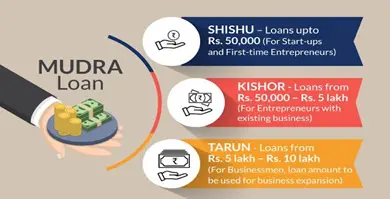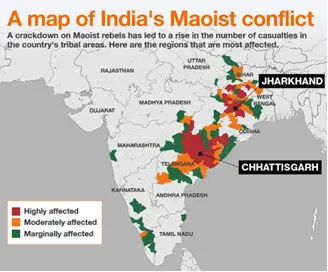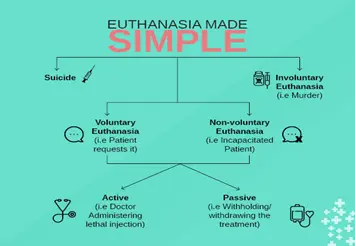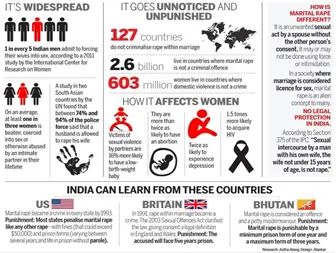Wednesday, 28th August 2024
Child Adoption in India
Why in the news?
- Over 18,000 adoptions since 2019; only 1,404 children with special needs find homes.
- As of July 5, 2024, 420 children with special needs were waiting for adoption in childcare institutions across India, according to CARA.
- The founder of NGO Families of Joy Avinash Kumar said that as of July 2024, 76% of the 1,709 children legally available for adoption were those with special needs
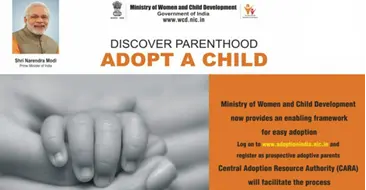
Central Adoption Resource Authority (CARA)
- About:
- Establishment: CARA is a statutory body created under the Juvenile Justice (Care and Protection of Children) Act, 2015.
- Function:
- It serves as the nodal authority for the adoption of Indian children, overseeing and regulating both in-country and inter-country adoptions.
- CARA manages the adoption of orphaned, abandoned, and surrendered children through recognized adoption agencies.
- International Role: CARA is designated as the Central Authority for intercountry adoptions in line with the Hague Convention on Intercountry Adoption, 1993, to which India acceded in 2003.
- Eligibility for Adoption:
- Who Can Be Adopted:
- Orphaned, abandoned, or surrendered children declared legally free for adoption by the Child Welfare Committee (CWC) under the JJ Act, 2015.
- Children of relatives (paternal or maternal uncles/aunts, or grandparents).
- Children surrendered by biological parents can be adopted by the step-parent.
- Who Can Adopt:
- Individuals or couples who are physically and mentally stable, financially capable, and without life-threatening medical conditions.
- Married couples require a stable marital relationship of at least two years and the consent of both spouses.
- Single women can adopt children of any gender, while single men are restricted from adopting female children.
- A minimum age difference of 25 years between the child and the prospective adoptive parents is required.
- Couples with three or more children are generally not considered, except for adopting children with special needs or hard-to-place children.
- Who Can Be Adopted:
Status of Child Adoption in India:
- Overview of Adoption:
- In India, the Central Adoption Resource Authority (CARA), part of the Ministry of Women and Child Development, regulates and monitors both in-country and inter-country adoptions.
- CARA operates in accordance with the Hague Convention on Intercountry Adoption, 1993, ratified by India in 2003.
- In 2019-20, India saw a total of 3,745 adoptions — 3,351 in-country and 394 international.
- Of the total number, only 56 boys and 110 girls with special needs were adopted, the Central Adoption Resource Authority (CARA) said in its response to an RTI query filed by PTI.
- In 2020-21, a total of 3,559 adoptions were recorded including 3,142 in-country and 417 inter-country.
- Only 110 boys and 133 girls with special needs were adopted this year. The number of adoptions dropped marginally to 3,405 — 2,991 in-country and 414 international — in 2021-22.
- The total number of adoptions included 136 boys and 206 girls with special needs. In 2022-23, 3,441 adoptions — 3,010 in-country and 431 inter-country — were recorded, with 156 boys and 188 girls with special needs finding adoptive families.
- The number of adoptions in 2023-24 increased significantly to 4,029 — 3,580 in-country and 449 international.
- These included 135 boys and 174 girls with special needs.
- Legal Framework:
- Hindu Adoption and Maintenance Act, 1956 (HAMA):
- Governs adoption for Hindus, Buddhists, Jains, and Sikhs. Adoption can be formalised through a "dattaka hom" ceremony, an adoption deed, or a court order.
- Juvenile Justice Act, 2015 (JJ Act):
- Governs adoption for non-Hindu communities.
- Prospective adoptive parents must register on CARA’s portal, followed by a home study report by a specialised adoption agency.
- Adoption is finalised after a legally free child is referred.
- Hindu Adoption and Maintenance Act, 1956 (HAMA):
- Recent Developments:
- Juvenile Justice (Care and Protection of Children) Amendment Act, 2021: Empowers District Magistrates (DMs) and Additional District Magistrates to issue adoption orders, a role previously assigned to civil courts.
- Adoption Regulations-2022:
- Introduced to streamline the adoption process, mandating real-time uploading of adoption orders and case statuses by DMs and Child Welfare Committees.
- Since implementation, 2,297 adoption orders have been issued, addressing a significant number of pending cases.
Major Challenges:
- Lengthy and Complex Process: The adoption process in India is often prolonged and bureaucratic. Currently, over 30,000 prospective parents are waiting, while fewer than 7% of children are legally free for adoption. The process can extend up to three years, especially for children with special needs.
- Illegal and Unregulated Practices: Instances of illegal activities such as baby trafficking and child-selling have been reported. In 2018, the Missionaries of Charity in Ranchi faced criticism for a baby-selling scandal. Unregistered adoption agencies also exploit vulnerable children and their families.
- Returning Children Post-Adoption: An increasing number of adopted children are being returned to care institutions. CARA reported over 1,100 children returned by adoptive parents in the last five years.
Way Forward:
- Strengthening Adoption Laws:
- There is a need to review and update adoption laws to simplify the process, enhance transparency, and protect the child’s best interests.
- This includes streamlining paperwork, reducing delays, and addressing legislative gaps.
- Post-Adoption Services:
- Comprehensive support services should be established to assist adoptive parents and children, including counselling, educational support, healthcare access, and guidance for managing post-adoption challenges.
- Awareness and Education:
- This involves informing the public about adoption benefits, procedures, and legal aspects, as well as fostering positive attitudes and dispelling misconceptions and stigma associated with adoption.
Conclusion:
Despite growing awareness and acceptance of adoption in India, the process is hindered by delays and systemic issues. Addressing these challenges through timely legal procedures, improved communication, and a more inclusive approach could help provide homes for more children.
Source: TH
Railways plans to go nuclear as part of its green drive
Why in the news?
- Indian Railways (IR) is exploring the use of nuclear power through captive units to increase its reliance on non-fossil fuel sources and renewable energy.
- This initiative is part of its broader strategy to reduce carbon emissions and achieve energy efficiency.
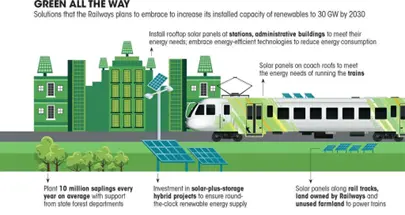
Nuclear-Powered Trains:
- About:
- A nuclear-powered train utilises the heat generated from a nuclear reaction to produce high-pressure steam.
- This steam drives turbines: one powers the train, while the other generates electricity for onboard equipment like air conditioners and lights.
- The concept was seriously considered in the 1950s by the USSR's Ministry of Transport.
- Functioning:
- The design involves a portable nuclear reactor that heats fluid to produce steam. This steam drives electric turbines, generating power for the train.
- Safety Considerations:
- Thorium reactors, known for their relatively low radiation risks, are being considered. The reactor’s design includes safety features to minimise risks and prevent misuse.
- Potential Benefits:
- Reduced Carbon Emissions: Nuclear power can significantly reduce CO₂ emissions compared to fossil fuels, aiding global climate change efforts.
- Energy Efficiency: Nuclear reactors provide high energy output with minimal fuel, potentially reducing operational costs and environmental impact over long distances.
- Low Infrastructure Requirements: Nuclear-powered trains could operate independently of overhead electric lines, reducing infrastructure costs and providing operational flexibility.
- Extended Range: These trains could travel long distances without frequent refuelling, benefiting both freight and passenger services.
- High Efficiency: Continuous power from nuclear reactors could optimise rail transport performance.
- Challenges:
- Radiation Risks: Handling nuclear materials and ensuring safety against radiation leaks are significant challenges requiring adequate shielding and safety measures.
- High Costs: Initial costs for developing and implementing nuclear-powered trains are substantial, including expenses for developing small, safe reactors.
- Technical Complexity: Designing and maintaining nuclear reactors for moving trains involves complex engineering challenges.
Indian Railways' Plans to Reduce Reliance on Fossil Fuels:
- Nuclear Power Exploration:
- Discussions with the Nuclear Power Corporation of India (NPCIL) are planned to explore the use of nuclear power.
- Indian Railways aims to have its own captive power plants, small reactors, and generating units.
- Net Zero Carbon Emission Target:
- Indian Railways aims to become a net zero carbon emitter by 2030. It will require 30,000 MW of renewable capacity by 2029-30.
- Current Renewable Energy Efforts:
- Indian Railways is partnering with organisations like Solar Energy Corporation of India (SECI), NTPC, and the Ministry of New and Renewable Energy (MNRE) to expand its renewable energy portfolio.
- In 2023, approximately 147 MW of solar plants and 103 MW of wind power plants were commissioned.
- Achievements:
- Railways has electrified nearly 63,500 km of its network, covering over 96% of the total broad-gauge network.
- Solar rooftop plants have been installed in 2,637 stations and service buildings, with a total power generation capacity of 177 MW.
Need for Alternative Energy Sources:
- High Energy Consumption:
- Indian Railways consumes over 20 billion kWh of electricity annually, around 2% of India's total power consumption, necessitating sustainable energy solutions.
- Increasing Power Demand:
- Power requirements are projected to grow significantly, from 4,000 MW in 2012 to approximately 15,000 MW by 2032, due to ongoing electrification efforts.
- Electrification Targets:
- Indian Railways aims to electrify 100% of its broad-gauge network by 2030, significantly increasing electricity demand and necessitating alternative energy sources.
- Environmental Impact:
- The reliance on diesel and electricity results in high CO₂ emissions. Indian Railways aims to reduce its emissions intensity by 33% below 2005 levels by 2030.
- Diminishing Revenue Surplus:
- Railways' revenue expenditure has grown faster than its revenue receipts, underscoring the need for cost optimization through energy efficiency and alternative energy sources.
- Cost Optimization:
- Indian Railways is the largest consumer of electricity, spending close to Rs 20,000 crore annually.
- It aims to reduce costs through renewable energy procurement and lower-cost power generation models.
Conclusion
The push for alternative energy in Indian Railways is driven by high energy consumption, rising demand, environmental concerns, and cost management needs. While Nuclear Powered Trains offer potential benefits in reducing emissions and boosting efficiency, challenges in safety, cost, and public acceptance must be overcome. With ongoing research and technological advancements, nuclear propulsion could become a viable option for future rail transport.
|
UPSC Civil Services Examination, Previous Year Questions (PYQs) Prelims Q:1 In the Indian context, what is the implication of ratifying the ‘Additional Protocol’ with the ‘International Atomic Energy Agency (IAEA)’? (2018)
Ans: (a)
Q:2 The function of heavy water in a nuclear reactor is to (2011)
Ans: (a)
Mains Q:1 The setting up of a Rail Tariff Authority to regulate fares will subject the cash strapped Indian Railways to demand subsidy for the obligation to operate nonprofitable routes and services. Taking into account the experience in the power sector, discuss if the proposed reform is expected to benefit the consumers, the Indian Railways or the private container operators. (2014) Q:2 Describe the benefits of deriving electric energy from sunlight in contrast to conventional energy generation. What are the initiatives offered by our government for this purpose? (2020) Q:3 With growing energy needs should India keep on expanding its nuclear energy programme? Discuss the facts and fears associated with nuclear energy. (2018) |
Upgrade for India's weather department in pipeline
Why in the news?
- Recently, A new mission to improve weather forecasting, with a budget of at least Rs 10,000 crore is expected to be launched soon.
- It is likely to be several times bigger than the existing National Monsoon Mission.
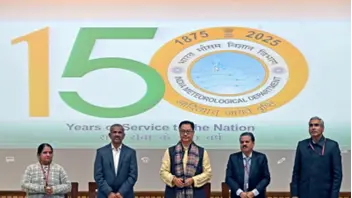
What is the National Monsoon Mission (NMM) ?
- About:
- Establishment: The NMM has made substantial progress in weather and climate forecasting by developing advanced models.
- Forecasting Periods: The models cover short-range (1-10 days), medium-range (10-30 days), and seasonal (up to one season) forecasts.
- Achievements: Over the past three years, these models have consistently demonstrated high accuracy in predicting key weather events.
- The targets of Monsoon Mission:
- Development of a seamless prediction system using monsoon mission model, on different time scales, like Seasonal (for the whole Monsoon season), Extended range (up-to 4 weeks), Short range prediction (up-to 5 days).
- Initiate and coordinate working partnership between Indian and foreign institutes to develop a system for prediction of extremes and climate applications
- Develop and implement systems for climate applications having social impacts (such as agriculture, flood forecast, extreme events forecast, wind energy, etc.)
- Advanced data assimilation system for preparing high quality data for model predictions.
- Major achievements of NMM during the last three years are:
- Setting up of an advanced prediction system for Seasonal prediction; Extended range prediction and Very high-resolution Short-range prediction.
- Commissioning of a Global Ensemble Forecast System (GEFS) for short and medium range prediction at 12 km.
- The operationalization of the Monsoon Mission dynamical model (MMCFS) to prepare an operational seasonal forecast of monsoon rainfall and temperatures during the hot and cold weather seasons over India.
- Use of MMCFS and extended range prediction system for preparing regional seasonal forecast outlook for south Asia under WMO recognised Regional Climate Center and South Asia Seasonal Climate Outlook Forum (SASCOF)activities.
- Development of an algorithm to monitor and predict the Monsoon Intrapersonal Oscillations (MISO) and Madden-Julian Oscillation (MJO) on the extended range.
- Development of an index to predict the genesis and evolution of tropical cyclones and other cyclonic disturbances over the north Indian Ocean.
- Probabilistic Quantitative Precipitation Forecast over all the Indian river basin have been operationally implemented.
- GFS/GEFS forecasts have been extensively used to provide guidance to Forest fire possibility and also to Renewable Energy Sectors namely, wind and solar.
- Development of a high-resolution regional reanalysis product, IMDAA at very high resolution of 12 km.
- The overarching objective of the Scheme is as follows:
- Augmentation of observations and their assimilation into weather and climate models
- Understanding the physical processes through field campaigns
- Developing and running of high-resolution models for giving forecast in all scales
- Translating science to service and it delivery to society
- Improving and acquiring the required infrastructure
- Challenges:
- Complexity of Monsoon Dynamics: Influenced by oceanic, land, and atmospheric conditions.
- Data Limitations: Inconsistent observational data, particularly in remote areas.
- International Collaboration: Aligning methodologies and data-sharing protocols can be complex.
- Adaptation to Climate Change: Incorporating new variables and uncertainties into prediction models.
- Regional Disparities: Ensuring timely and accurate forecasts for all regions, especially vulnerable areas.
IMD to Improve Weather Forecasting Capabilities
- About:
- Upgrade: The Indian Meteorological Department (IMD) is set to receive a major upgrade to enhance weather forecasting, especially for localised and extreme weather events.
- Budget: The new mission, with a budget of at least Rs 10,000 crore, aims to improve IMD's local prediction accuracy.
- Focus Areas:
- Advanced Models: Develop computer simulation models suited to India's climate.
- Infrastructure Enhancement: Deploy sophisticated instruments such as Doppler radars and new weather satellites.
- AI/ML Integration: Use artificial intelligence and machine learning to improve hyperlocal forecasting. Experimental models in cities like Mumbai have shown promise.
- Significance:
- Addressing Challenges: The mission aims to tackle issues exposed by recent extreme weather events like heavy rainfall, landslides, and floods.
- Improving Accuracy: Enhance local prediction capabilities to better manage and respond to extreme weather conditions.
Source: IE
RBI to launch Unified Lending Interface
Why in the news?
- The Reserve Bank of India (RBI) is piloting the Unified Lending Interface (ULI), a groundbreaking platform aimed at revolutionising the lending process in India.
- ULI is expected to become the "UPI" of the credit sector, offering a frictionless credit experience. The platform is set for a nationwide launch soon.
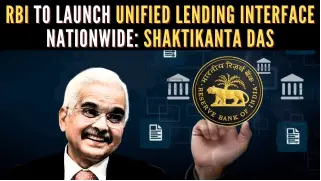
Unified Lending Interface (ULI)
- Background:
- Pilot Project Initiation: In August 2023, the RBI launched a pilot project to create a public tech platform designed to streamline credit processes. The aim was to reduce costs, expedite disbursements, and enhance scalability.
- Naming of ULI: RBI Governor proposed naming this platform the Unified Lending Interface (ULI), drawing a parallel with how UPI revolutionised payments in India. ULI is anticipated to have a similar transformative impact on lending.
- Need for ULI:
- Digitalization and Innovation: India's rapid digitalization has fostered innovation in payments, credit, and financial services by banks, NBFCs, fintech companies, and startups.
- Data Fragmentation: However, credit appraisal data is scattered across various systems, creating barriers to smooth and timely lending. ULI aims to overcome these obstacles.
- About ULI:
- Seamless Information Flow: ULI will enable a consent-based flow of digital information, including state land records, from multiple sources to lenders. This will expedite credit appraisals, particularly for smaller and rural borrowers.
- Standardised APIs: The platform will simplify technical integrations through standardised APIs, reducing the need for extensive documentation and making credit delivery quicker and more efficient.
- Plug-and-Play Approach: ULI is designed for a plug-and-play approach to enable quicker access for lenders. It also ensures data privacy by operating on the consent of potential borrowers.
- Benefits:
- Addressing Credit Demand: ULI will address the large unmet demand for credit, especially in agriculture and MSME sectors, by digitising access to financial and non-financial data currently housed in separate systems.
- Significant Advancement: Experts view ULI, alongside JAM (Jan Dhan, Aadhaar, Mobile) and UPI, as a significant advancement in India's digital infrastructure.
Unified Payments Interface (UPI)
- About:
- System Overview: UPI is a system that integrates multiple bank accounts into a single mobile application, merging various banking features, fund routing, and merchant payments under one platform.
- Launch: UPI was launched in 2016 by the National Payments Corporation of India (NPCI).
- Features of UPI:
- Instant Money Transfer: UPI allows immediate money transfer through mobile devices, available 24/7 and 365 days a year.
- Single Application: It provides a single mobile application for accessing different bank accounts.
- Hassle-Free Transactions: Customers are not required to enter details like Card number, Account number, or IFSC, making transactions simpler.
- Benefits of UPI:
- For Banks: UPI offers a universal application for transactions, single-click two-factor authentication, and a safer, more secure transaction process.
- For Merchants: It enables easier fund collection, In-App Payments (IAP), and eliminates the risk of storing customer’s virtual addresses.
- For Customers: UPI provides a single application for various bank accounts, round-the-clock availability, easy complaint resolution through the app, and secure transactions using a Virtual ID.
- UPI Transaction Statistics:
- July 2024 Data: According to NPCI data, UPI transactions in July 2024 amounted to Rs 20,64,292.40 crore in value, with a total transaction count of 14,435.55 million.
Source: IE
India 3 new Ramsar sites
Why in the news?
- Recently, three new wetlands have got the Ramsar site tag taking the total tally of Ramsar wetlands to 85 in India.
- The three new Ramsar sites are Nanjarayan Bird Sanctuary and Kazhuveli Bird Sanctuary in Tamil Nadu and Tawa Reservoir in Madhya Pradesh.
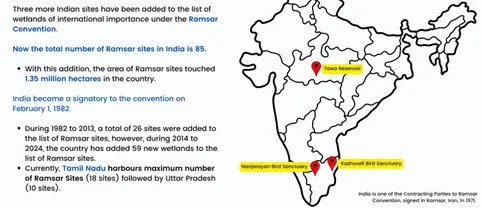
What are Wetlands?
- About:
- Wetlands are areas where water is either present at or near the surface, creating distinctive ecosystems.
- The Ramsar Convention defines wetlands as regions that can be natural or artificial, permanent or temporary, with water that may be static or flowing, and can be fresh, brackish, or saline.
- This definition includes marshes, fens, peatlands, and shallow marine waters up to six metres deep at low tide, highlighting the diversity of wetland types and their role in both inland and coastal environments.
- Significance: Wetlands are vital for:
- Climate Regulation: Through carbon sequestration, wetlands store carbon dioxide from the atmosphere.
- Ecosystem Productivity: They are among the most productive ecosystems globally, comparable to rainforests and coral reefs.
- Biodiversity: Wetlands maintain biodiversity, regulate water cycles, and purify water naturally.
- Economic and Environmental Stability in India: Indian wetlands, such as the Sundarbans and Chilika Lake, provide crucial habitats for wildlife, support fisheries and agriculture, and play a role in flood control.
- Extent in India:
- India's wetlands cover approximately 15,260,572 square kilometres (sq km), about 4.63% of the total geographical area.
- Of this, inland-natural wetlands constitute 45%, and coastal-natural wetlands account for 25%.
- Notable states with significant wetland coverage include Lakshadweep (96.12%), Andaman and Nicobar Islands (18.52%), Daman and Diu (18.46%), and Gujarat (17.56%).
- Conservation Efforts: India has undertaken several initiatives to protect wetlands, including:
- National Wetland Conservation Programme (1986)
- National Plan for Conservation of Aquatic Wetlands (2015)
- Identification of over 2,200 wetlands for conservation by the Ministry of Environment, Forest and Climate Change
What are Ramsar Sites?
- About:
- The Ramsar Convention, established in 1971 in Ramsar, Iran, is an international treaty aimed at conserving and sustainably using wetlands.
- It encourages the designation of "Ramsar sites," which are wetlands of international importance due to their unique ecological features.
- Member countries are required to maintain the ecological character of these sites and promote their sustainable management.
- Membership:
- The Convention has 172 signatory countries.
- Associated organisations include the International Union for Conservation of Nature and the World-Wide Fund for Nature.
- Criteria for Selection: Ramsar sites are selected based on criteria such as:
- Support for Species: Wetlands that support plant and/or animal species at critical stages of their life cycles or provide refuge during adverse conditions.
- Habitat Capacity: Sites that support significant fish and waterbird populations.
- India's Involvement:
- India acceded to the Ramsar Convention in 1982, initially designating Chilika Lake and Keoladeo National Park as Ramsar sites. It now has one of the highest numbers of Ramsar sites in Asia.
Recent Additions:
- Nanjarayan Bird Sanctuary, Tamil Nadu
- Description:
- Location and Size: A vast, shallow wetland situated in Tamil Nadu, covering an area of 125.865 hectares.
- Historical Significance: Named after King Nanjarayan, who historically restored the lake.
- River Flowing Through It:
- Located on the banks of the Noyal River.
- Significance:
- Acts as a crucial feeding and nesting ground for both resident and migratory birds.
- Serves as an essential water source for local agricultural activities.
- Biodiversity:
- Birds: 191 species
- Butterflies: 87 species
- Amphibians: 7 species
- Reptiles: 21 species
- Small Mammals: 11 species
- Plants: 77 species
- Fauna:
- Commonly found species include pelicans, painted storks, coots, Eurasian coot, spot-billed duck, and various herons.
- Description:
- About Kazhuveli Sanctuary, Tamil Nadu
- Description:
- Location and Size: Situated on the Coromandel Coast of Tamil Nadu, covering 5,151.6 hectares.
- Connectivity: The shallow brackish lake connects to the Bay of Bengal via the Uppukalli Creek and Edayanthittu Estuary.
- Designation: Declared Tamil Nadu’s 16th bird sanctuary in 2021.
- Ecosystem:
- Comprises salt marshes, mudflats, and shallow waters.
- Significance:
- Flood Control and Groundwater Recharge: Helps in managing floods and recharging groundwater.
- Migratory Birds: Serves as a feeding ground for long-distance migratory birds from Central Asia and Siberia, including Black-tailed Godwits, Eurasian Curlews, White Storks, Ruffs, and Dunlins.
- Endangered Species: Supports globally endangered species such as the black-headed ibis and greater flamingo.
- Flora:
- Features degraded mangrove patches with Avicennia species and extensive reed beds.
- Fauna:
- Includes spot-billed pelicans, darters, cormorants, herons, egrets, storks, black ibis, spoonbills, flamingos, spot-billed ducks, garganeys, common pochards, sandpipers, coots, shanks, and terns.
- Description:
- About Tawa Reservoir, Madhya Pradesh
- Description:
- Location: Located in Madhya Pradesh within the Satpura Tiger Reserve, marking the western boundary of Satpura National Park and Bori Wildlife Sanctuary.
- Rivers: Situated at the confluence of the Tawa and Denwa rivers.
- Significance:
- Irrigation and Water Supply: Provides irrigation water for surrounding farmlands and drinking water to local communities.
- Bird Migration: Serves as a major wintering ground for migratory birds.
- Description:
|
UPSC Civil Services Examination Previous Year Question (PYQ) Prelims Q:1 If a wetland of international importance is brought under the ‘Montreux Record’, what does it imply? (2014)
Ans: (a)
Mains Q:1 What is wetland? Explain the Ramsar concept of ‘wise use’ in the context of wetland conservation. Cite two examples of Ramsar sites from India. (2018) |
Source: IE
Education Ministry defines ‘literacy,’ ‘full literacy
Why in the news?
- The Union Ministry of Education (MoE) has recently defined "literacy" and outlined the criteria for "full literacy" under the New India Literacy Programme (NILP) to enhance adult literacy across States.
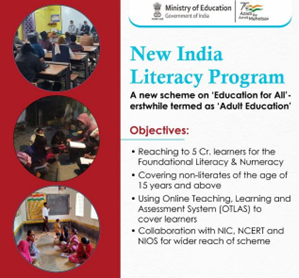
What is the New India Literacy Programme (NILP)?
- About:
- Name: ULLAS - Nav Bharat Saksharta Karyakram/NILP.
- Launched By: Ministry of Education (MoE).
- Duration and Funding: Implemented from FY 2022-23 to 2026-27 with a financial outlay of Rs. 1,037.90 crore (Central share: Rs. 700.00 crore; State share: Rs. 337.90 crore).
- Objective: To empower adults aged 15 and above who missed formal schooling, aiding their integration into society and contributing to national growth.
- Components:
- Foundational Literacy and Numeracy (FLN).
- Critical Life Skills.
- Vocational Skills Development.
- Basic Education.
- Continuing Education.
- Beneficiaries:
- Identified through door-to-door surveys using a mobile app by State/UT surveyors.
- Non-literates can also register directly via the mobile app.
- Other Information:
- The scheme relies on volunteerism, with volunteers registering through the mobile app.
- Primarily technology-based, implemented online.
- Teaching materials are available on the DIKSHA platform of NCERT and accessible via mobile apps.
- Additional dissemination modes include TV, Radio, and Samajik Chetna Kendra.
- Who is Considered Literate under the NILP?
- Meaning of Literacy:
- Literacy involves the ability to read, write, and compute with comprehension, including critical life skills such as digital and financial literacy.
- Meaning of Full Literacy:
- A State/UT achieving 95% literacy is considered fully literate.
- Literate Declaration:
- Individuals are declared literate after passing the Foundational Literacy and Numeracy Assessment Test (FLNAT).
- In 2023, 3,994,563 adult learners took the FLNAT exams, with 3,617,303 certified as literate.
- Significant Literacy Challenge Faced by India:
- Large Number of Non-Literates:
- Census 2011 data shows 25.76 crore non-literate individuals aged 15 and above.
- Disadvantage for Women:
- Of the non-literate population, 9.08 crore are males, and 16.68 crore are females.
- Challenges Faced by Non-Literates:
- Difficulties in financial transactions, job applications, media comprehension, understanding rights, and participation in higher productivity sectors.
- Ineffectiveness of Previous Initiatives:
- Despite the Saakshar Bharat program (2009-10 to 2017-18) certifying 7.64 crore as literate, 18.12 crore adults remain illiterate.
- Exam Pass Percentage:
- FLNAT pass percentage dropped from 89.64%-91.27% in 2023 to 85.27% in 2024.
- Budget Allocation Issues:
- NILP’s allocation was reduced from ₹157 crore in 2023-24 to ₹100 crore in revised estimates.
Source: TH
New India Literacy Programme (NILP)
Why in the news?
- The New India Literacy Programme (NILP) is a centrally sponsored initiative by the Union Ministry of Education aimed at promoting literacy among individuals aged 15 and above in India.
- This program focuses on reducing illiteracy rates by providing comprehensive educational resources and support to non-literates.
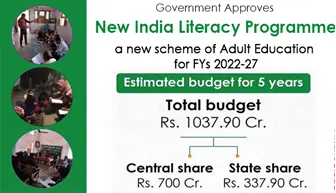
Key Features of NILP:
- Objective:
- The NILP aims to achieve full literacy by engaging one crore learners annually across all States and Union Territories during the financial years 2022-23 to 2026-27.
- Financial Outlay:
- The program has a total financial outlay of Rs. 1037.90 crore, allocated for its implementation over the five-year period.
- Target Group:
- The scheme focuses on individuals aged 15 years and above who are non-literate.
- Five Components of NILP:
- Foundational Literacy and Numeracy: Basic reading, writing, and arithmetic skills.
- Critical Life Skills: Including financial literacy, digital literacy, legal literacy, healthcare, childcare, family welfare, etc.
- Basic Education: Equivalency education for preparatory (classes 3-5), middle (classes 6-8), and secondary (classes 9-12) stages.
- Vocational Skills: Continuous learning process for skill development to obtain local employment.
- Continuing Education: Holistic adult education courses in various fields like arts, sciences, technology, culture, sports, recreation, and other topics relevant to local learners.
- Implementation Mechanism:
- Volunteerism: The scheme is primarily volunteer-driven, with volunteers registering via a mobile app to assist in teaching.
- Technology-Based: NILP leverages digital platforms for content delivery, predominantly through online modes. Teaching and learning materials are available on the DIKSHA platform of NCERT and can be accessed via mobile apps.
- Survey and Registration: Beneficiaries are identified through door-to-door surveys conducted via mobile apps. Non-literate individuals can also register directly through the app.
- Dissemination Channels:
- Besides digital platforms, the program uses TV, Radio, and Samajik Chetna Kendra for spreading foundational literacy and numeracy.
- Community Involvement:
- The program encourages the participation of Self-Help Groups (SHGs), voluntary organisations, and other community-based groups.
Definition of Literacy:
- Literacy under NILP is defined as the ability to read, write, and compute with comprehension, along with acquiring critical life skills like digital and financial literacy.
- Full Literacy: Achieving a 95% literacy rate in a State or Union Territory will be considered equivalent to 100% literacy.
- Literacy Assessment: A non-literate person is deemed literate under NILP after passing the Foundational Literacy and Numeracy Assessment Test (FLNAT).
Source: TH
Polaris Dawn Mission
Why in the news?
- The Polaris Dawn Mission is an ambitious private spaceflight endeavour aiming to push the boundaries of commercial space exploration.
- Spearheaded by billionaire entrepreneur Jared Isaacman, this mission will set several records and conduct groundbreaking research in space.

Key Highlights:
- About:
- First Private Spacewalk: The mission will mark the first-ever spacewalk conducted by non-professional astronauts, setting a new precedent in commercial space exploration.
- Unprecedented Altitude: The mission will reach an altitude of approximately 700 kilometres (435 miles) above Earth, surpassing the orbit of the International Space Station (ISS) and navigating through the Van Allen radiation belts.
- Spacecraft:
- The mission will utilise SpaceX's Falcon 9 rocket and Dragon capsule.
- The spacecraft aims to break the altitude record set by NASA’s Gemini 11 mission in 1966, which reached 1,373 kilometres.
- Crew Leadership: Jared Isaacman, known for financing and flying on SpaceX’s Inspiration4 mission, leads this mission.
- Van Allen Belts:
- Composition and Location:
- The Van Allen Belts consist of charged particles trapped by Earth's magnetosphere.
- The inner belt is composed primarily of high-energy protons, located between 680 and 3,000 kilometres above Earth.
- The outer belt, at 15,000 to 20,000 kilometres, consists mainly of high-energy electrons.
- Radiation Risks: The crew will be exposed to higher levels of radiation due to the mission's trajectory through the Van Allen Belts, increasing the risks of radiation sickness, tissue damage, and cancer.
- Composition and Location:
- Significance of the Spacewalk:
- Navigating the Van Allen Belts: This mission's ability to traverse these radiation-intense regions is crucial for future deep-space missions, such as those planned for Mars.
- Testing New Spacesuits: SpaceX-developed spacesuits will be tested during the spacewalk to assess their effectiveness in protecting against heightened radiation levels.
- Planned Health Research:
- Biological Effects: The mission will study the impact of space travel on human biology, including the effects on eyesight and brain structure, particularly focusing on Spaceflight-Associated Neuro-ocular Syndrome (SANS).
- Decompression Sickness: Research will also address decompression sickness, a condition caused by nitrogen gas bubbles that can damage human tissue during spaceflight.
- Innovation in Space Communications:
- Laser Communications Test:
- The crew will test SpaceX’s Starlink satellite network’s laser communications, a technology critical for future lunar and Martian missions.
- This test will provide valuable data for developing advanced space communication systems.
- Laser Communications Test:
- Future Polaris Missions:
- Mission Progression: Jared Isaacman has committed to three Polaris missions, each pushing the boundaries of human spaceflight, communications, and scientific research.
- Starship Test: The third Polaris mission is expected to involve the first crewed test of SpaceX’s reusable Starship spacecraft, further advancing space exploration capabilities.
Source: IE
Registration of Exotic Pets-PARIVESH 2.0 Portal
Why in the news?
- The Union Ministry of Environment, Forest and Climate Change (MoEFCC) has mandated the registration of exotic pets listed under Schedule IV of the Wildlife Act through the PARIVESH 2.0 portal.
- This registration must be completed within six months.
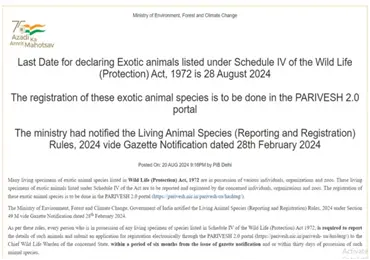
About Exotic Species:
- Definition: Exotic species are animals or plants that are moved from their natural habitats to new locations, often due to human activities.
- Criteria: Under the Living Animal Species (Reporting and Registration) Rules, 2024, individuals possessing species listed under Schedule IV of the Wildlife (Protection) Act, 1972, are required to report and register them.
- Wildlife (Protection) Amendment Act, 2022: This amendment mandates the registration of possession, transfer, birth, and death of species listed in the CITES Appendices and Schedule IV of the Wildlife (Protection) Act, 1972.
Concerns with Exotic Species:
- Non-regulation: Many exotic species are imported and bred in India without proper registration, posing risks such as zoonotic diseases.
- Pandemic Risk: The unregulated trade and ownership of exotic animals can lead to a heightened risk of pandemics.
- Smuggling Concerns: There is increasing smuggling of endangered exotic animals into India, particularly from Southeast Asia. Significant seizures of animals like Kangaroos, Koalas, and Lemurs have been reported in states like Assam and Mizoram.
About the PARIVESH 2.0 Portal:
- PARIVESH 2.0:
- This is a web-based workflow application developed by the MoEFCC.
- It facilitates the online submission and monitoring of proposals related to environmental, forest, wildlife, and coastal regulation zone clearances.
- Registration Requirement:
- Individuals, organisations, and zoos possessing exotic animal species listed under Schedule IV of the Wildlife (Protection) Act, 1972, must report and register these species on the PARIVESH 2.0 portal.
- This is a crucial step for regulating and monitoring exotic species in India.
Source: PIB
RHUMI-1: India's First Reusable Hybrid Rocket
Why in the news?
- India has achieved a significant milestone by launching its first reusable hybrid rocket, RHUMI-1.
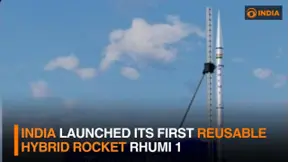
About RHUMI-1:
- India's First Reusable Hybrid Rocket: RHUMI-1 marks a pioneering step in India's space technology, being the country's first rocket designed for reuse with a hybrid propulsion system.
- Development: It was developed by the Tamil Nadu-based startup Space Zone India in collaboration with the Martin Group.
- Hybrid Propulsion System:
- RHUMI-1 features an innovative hybrid propulsion system that combines the benefits of both liquid and solid fuels.
- The rocket uses a solid propellant and a liquid oxidizer, with these components only coming together during combustion, thus reducing the risk of accidental detonation.
- Efficiency and Cost-Effectiveness: The hybrid design promises improved efficiency and reduced operational costs, making it a breakthrough in space technology.
- Eco-Friendly Features:
- RHUMI-1 is equipped with a CO₂-triggered parachute system, an environmentally friendly and cost-effective mechanism that ensures the safe recovery of rocket components post-launch.
- Additionally, the rocket is completely free of fireworks and does not use Trinitrotoluene (TNT).
About the Launch:
- Launch Location: RHUMI-1 was launched from the East Coast Road Beach in Thiruvidandhai, Chennai.
- Payload: The rocket carried three Cube Satellites and 50 Pico Satellites. These were launched into a suborbital trajectory.
- Hydraulic Mobile Launch System: The rocket utilised India’s first hydraulic mobile launch system, which allows for flexible and adaptable launch operations from various locations and angles between 0 to 120 degrees.
- Mission Objectives:
- Cube Satellites: These are designed to monitor and collect data on atmospheric conditions, such as cosmic radiation intensity, UV radiation intensity, and air quality.
- Pico Satellites: These will focus on analysing environmental factors like vibrations, accelerometer readings, altitude, ozone levels, and toxic substances, contributing valuable insights into atmospheric dynamics.
Source: TH
Transforming India’s Food Processing Sector
Context:
- Despite the government's prioritisation of agricultural development, including a substantial budget allocation of ₹1.52 lakh crore in 2024-25, agri-exports have underperformed.
- Only 25% of agricultural exports are processed or value-added, a figure stagnant for a decade.
- The Production Linked Incentive Scheme for the Food Processing Industry (PLISFPI) has seen slow implementation, with only 10% of allocated funds utilised midway through its timeline.
- To compete globally and realise its potential, India must improve its performance in this sector.

What is Food Processing?
- About:
- Food processing refers to the methods and techniques used to transform raw plant and animal materials into edible products.
- It includes a wide range of operations, from simple preservation to complex industrial methods.
- Levels of Processing:
- Primary Processing: Involves basic cleaning, grading, and packaging of agricultural products.
- Secondary Processing: Involves converting ingredients into edible products (e.g., milling wheat into flour).
- Tertiary Processing: Involves creating ready-to-eat foods (e.g., baking bread from flour).
- Key Objectives:
- Preservation: Extending the shelf life of food products.
- Safety: Eliminating harmful microorganisms and contaminants.
- Quality Enhancement: Improving taste, texture, and nutritional value.
- Convenience: Creating easy-to-prepare or ready-to-eat products.
- Value Addition: Increasing the economic value of raw agricultural produce.
What are the Key Factors Driving the Growth of the Food Processing Sector in India?
- Demographic Dividend Drives Demand:
- India's large and growing population, coupled with rising incomes and urbanisation, is fuelling demand for processed foods.
- With 65% of the population under 35 years old, changing lifestyles and food preferences are reshaping the market.
- The Indian processed food market is expected to grow from USD 263 billion in 2019-20 to USD 470 billion by 2025.
- This growth is evident in the increasing popularity of ready-to-eat meals.
- Digital Revolution - From Farm to Phone to Plate:
- The rapid digitalization of India's food supply chain is transforming the sector.
- E-commerce platforms and food delivery apps have expanded market access for processed food products.
- The government's Digital India initiative has facilitated direct farmer-processor connections, reducing intermediaries.
- Ninja cart, a B2B fresh produce supply chain company, connects vegetable and fruit farmers directly with businesses, showcasing the potential of digital integration in the food processing ecosystem.
- Government Policies - Catalysing Growth:
- Supportive government policies have been crucial in driving the food processing sector.
- The Production Linked Incentive Scheme for Food Processing Industry (PLISFPI), launched in 2021, allocated ₹10,900 crore to boost domestic manufacturing and exports.
- The 100% FDI allowance in food processing through the automatic route has attracted significant foreign investment.
- For example, Nestlé announced plans to invest ₹5,000 crore in India by 2025, focusing on capacity expansion and new product development in the processed food segment.
- Innovation - The Flavor of Success:
- Product innovation is a key driver, with companies constantly introducing new offerings to meet evolving consumer preferences.
- The focus on health-conscious and functional foods has led to a surge in innovative products.
- For instance, ITC's 'Farmland' frozen foods range, which emphasises preservative-free, minimally processed products, saw rapid growth in FY 2023-24.
- The incorporation of traditional Indian ingredients in modern formats, such as GAIA's millet-based snacks, has also gained traction.
- Agri-Tech - Sowing Seeds of Processing:
- The integration of technology in agriculture is indirectly boosting the food processing sector.
- Agri-Tech startups raised over USD 706 million in funding in 2023, indicating strong growth potential.
- Companies like CropIn, which uses AI and satellite monitoring to improve crop yield and quality, are partnering with food processors to ensure a consistent supply of high-quality raw materials.
- This technological intervention is crucial for contract farming arrangements, increasingly popular among food processing companies to secure their supply chains.
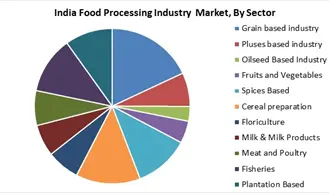
What are the Major Issues Related to the Food Processing Sector in India?
- Fragmented Supply Chain - The Broken Link:
- The food processing sector in India suffers from a highly fragmented supply chain, leading to inefficiencies.
- Over 86% of farmers are small and marginal, complicating the aggregation of produce.
- Multiple intermediaries add costs without proportional value addition.
- Farmers receive only 30-35% of the value of their produce, compared to 65-70% in developed economies.
- Lack of direct farmer-processor linkages affects raw material quality and impacts cost competitiveness.
- Infrastructure Deficit - The Cold Reality:
- India's cold chain infrastructure is inadequate despite recent investments.
- As the second-largest producer of fruits and vegetables, 25-30% of these products are lost or damaged annually due to inadequate infrastructure.
- Post-harvest losses are estimated at ₹92,651 crore annually, according to the Ministry of Food Processing Industries.
- The uneven geographical distribution of facilities poses challenges, especially in rural and semi-urban areas.
- Regulatory Labyrinth - Tangled in Red Tape:
- The complex regulatory framework creates significant operational challenges.
- Food processors must navigate regulations from FSSAI, Agricultural and Processed Food Products Export Development Authority, BIS, and state agencies.
- The lack of a single-window clearance system and frequent regulatory changes increase compliance costs and create uncertainty, impacting SMEs.
- Skills Gap - The Missing Ingredient:
- The sector faces a shortage of skilled workforce due to insufficient specialised training programs and industry-academia collaboration.
- Only 3% of the workforce in food processing has formal training.
- The skills gap affects product quality, innovation, and adoption of new technologies, particularly in food safety management, quality control, and R&D.
- Capital Crunch - Starved for Funds:
- Access to capital is a challenge, especially for MSMEs.
- High risk perception due to seasonality, perishability, and market volatility results in stringent lending norms and higher interest rates.
- Limited access to funds restricts investments in technology upgradation, capacity expansion, and R&D.
- Quality Conundrum - The Standards Struggle:
- Inconsistent quality standards impact domestic consumption and export potential.
- Implementation of FSSAI regulations remains a challenge, especially among smaller processors.
- Quality inconsistencies pose health risks and erode consumer trust.
- Frequent export rejections due to quality issues, as seen with contamination in 527 products linked to India between September 2020 and April 2024, affect India's global competitiveness.
- Lack of harmonisation with international standards further complicates export efforts.
- Packaging Paradox - Wrapped in Challenges:
- The growing food packaging industry faces sustainability and cost issues.
- Flexible and rigid packaging constitute 59% of total plastic consumption, raising environmental concerns.
- The push for sustainable packaging (e.g., ban on single-use plastics) forces rapid changes, with the industry struggling to find cost-effective alternatives.
- Market Volatility - The Price Rollercoaster:
- Extreme price fluctuations in agricultural commodities pose risks to food processors.
- Seasonal production and climate vulnerabilities lead to frequent price shocks.
- For example, tomato prices surged by 400% in mid-2023 due to adverse weather, affecting processors of tomato-based products.
- Volatility challenges processors in maintaining consistent pricing and quality, impacting domestic stability and export commitments.
What are the Key Government Initiatives Related to the Food Processing Sector?
- Priority Sector Lending (PSL) Inclusion:
- Food and agro-based processing units, along with cold chain infrastructure, are included as priority sectors under PSL norms to facilitate easier access to finance.
- 100% Foreign Direct Investment (FDI):
- Automatic route approval for foreign investment in the food processing sector to attract international capital.
- Special Food Processing Fund:
- Establishment of a ₹2,000 crore fund managed by the National Bank for Agriculture and Rural Development (NABARD) to support food processing initiatives.
- Pradhan Mantri Kisan Sampada Yojana:
- A scheme aimed at enhancing food processing infrastructure and promoting value addition.
- Pradhan Mantri Formalisation of Micro Food Processing Enterprises Scheme:
- A scheme focused on the formalisation and improvement of micro food processing enterprises.
- Production Linked Incentive (PLI) Scheme for Food Processing Industry:
- A scheme designed to boost domestic manufacturing and exports in the food processing sector through incentives.
What Measures Can Be Adopted to Enhance the Food Processing Sector in India?
- Food-Cluster Development:
- Develop integrated food processing zones near major agricultural production areas, incorporating shared infrastructure such as cold storage and quality testing labs.
- Encourage ancillary industries like packaging and logistics within these clusters to create a comprehensive ecosystem.
- Tech-Driven Supply Chain - From Soil to Shelf:
- Invest in technology-driven supply chain management with blockchain for traceability, IoT sensors for real-time monitoring, AI for demand forecasting, and drones and satellite imaging for crop monitoring.
- Financial Re-engineering of the Food Processing Sector:
- Create sector-specific credit schemes with flexible terms, a credit guarantee fund to encourage bank lending, and tax incentives for private equity and venture capital investments in food-tech startups.
- Quality Standardisation:
- Implement a quality standardisation program aligning Indian standards with global norms, introduce tiered certification for processors, establish mobile quality testing labs, and integrate quality parameters into the e-NAM platform.
- Regulatory Streamlining - Cutting the Red Tape:
- Overhaul regulatory processes to establish a single-window clearance system, develop a unified digital platform for real-time updates, and streamline approval processes to reduce setup time.
- Sustainable Processing - Green from Farm to Fork:
- Develop a sustainability framework with tiered green certification, fiscal incentives for renewable energy and water recycling, and support for biodegradable packaging through R&D grants and tax incentives.
- Export Ecosystem - Global Flavors, Local Roots:
- Create dedicated export zones with infrastructure and single-window clearance, develop country-specific strategies for product customization, and implement a market intelligence system for real-time data on global demand and price trends.
- Prioritise attracting major food processing firms to enhance growth, drawing inspiration from successful models like Apple's electronics sector.
- R&D Acceleration - Innovate to Elevate:
- Boosted R&D through Food Innovation Labs, weighted tax deductions on R&D expenses, and a national database of traditional food processing techniques for scientific validation and scale-up.
|
UPSC Civil Services Examination Previous Year Question (PYQ) Prelims
Q:1 With what purpose is the Government of India promoting the concept of “Mega Food Parks”? (2011)
Select the correct answer using the codes given below:
Ans: (b)
Mains Q:1 What are the reasons for the poor acceptance of a cost-effective small processing unit? How can the food processing unit be helpful to uplift the socioeconomic status of poor farmers? (2017) |
Source: TH
Share the article
Edukemy’s Current Affairs Quiz is published with multiple choice questions for UPSC exams
MCQ
Get Latest Updates on Offers, Event dates, and free Mentorship sessions.

Get in touch with our Expert Academic Counsellors 👋
FAQs
UPSC Daily Current Affairs focuses on learning current events on a daily basis. An aspirant needs to study regular and updated information about current events, news, and relevant topics that are important for UPSC aspirants. It covers national and international affairs, government policies, socio-economic issues, science and technology advancements, and more.
UPSC Daily Current Affairs provides aspirants with a concise and comprehensive overview of the latest happenings and developments across various fields. It helps aspirants stay updated with current affairs and provides them with valuable insights and analysis, which are essential for answering questions in the UPSC examinations. It enhances their knowledge, analytical skills, and ability to connect current affairs with the UPSC syllabus.
UPSC Daily Current Affairs covers a wide range of topics, including politics, economics, science and technology, environment, social issues, governance, international relations, and more. It offers news summaries, in-depth analyses, editorials, opinion pieces, and relevant study materials. It also provides practice questions and quizzes to help aspirants test their understanding of current affairs.
Edukemy's UPSC Daily Current Affairs can be accessed through:
- UPSC Daily Current Affairs can be accessed through Current Affairs tab at the top of the Main Page of Edukemy.
- Edukemy Mobile app: The Daily Current Affairs can also be access through Edukemy Mobile App.
- Social media: Follow Edukemy’s official social media accounts or pages that provide UPSC Daily Current Affairs updates, including Facebook, Twitter, or Telegram channels.

